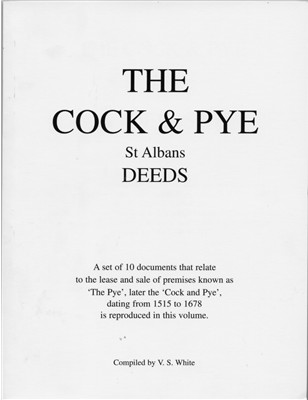The Cock & Pye
St Albans
Deeds
Victor S. White
The Author, 2001, ISBN 0-9540129-1-7
A4 Paperback, 184 pages
A set of 10 documents that relate to the lease and sale of premises known as 'The Pye'. later the 'Cock and Pye'. dating from 1515 to 1678 is reproduced in this volume.
| How long premises now known as
'The Cock & Pye' and once as
'The Pye' stood on the same plot in
St. Peter's Street is not determined from
this set of deeds. Certainly 'The Pye' was thriving five hundred years
ago when in the possession of William
Hardyng. Ownership passed down through the Sleape family of
Sleapeside, Roberte
Cocke, his son Andrewe,
Edward Parratt,
Thomas Woodward and Pierce Thompson to
arrive at the hands of Edward Moore by 1652 during
Cromwell's regime. In 1515, William Hardyng allowed his land, tenement and two
shops collectively identified as 'The Pye' together with two fish stalls
in the 'Oldeshamels' to transfer to the tenure of
William Potter, Nicholas
Walwyn, Thomas Robyns,
Thomas Vyall and William
Gascoyne. Previously these same assets had been in the occupation of
Thomas and Margaret
Fyssher, Thomas West,
William Drayton, Thomas Hethnes and
William Stepneth.
In 1515 the western boundary of 'The Pye' was St. Peter's Street and the eastern was the 'Houndespath', by 1599 the eastern boundary was called 'Towne man dyche'. The progression of people either in occupation of 'The Cock & Pye' or arising in the documentation associated with the thread of ownership includes William Cutberde (butcher), Alban Thrale, William Barnes (oatmealman), Robert Ivory (tanner), Joan Flindell, Thomas Flindell and Anne his sister. In l6l6 the property contained a malt mill and by 1650 boasted a bucket well. At the present day The Bell in that part of historic St. Peter's Street now renamed Chequer Street includes, or is adjacent to, the medieval plot once occupied by 'The Cock & Pye'. [From the back cover] |
In the past, when a property changed hands, it would be accompanied by a bundle of documents recording ownership and other relevant events. These often went back several hundred years, and the earliest document was often a summary of earlier documents. Unfortunately, with the coming of the Land Registry in the 20th century, these records were no longer needed to establish ownership and may have been lost - which is a pity as not only do they record the history of the buildings but also the people who owned, lived and worked in them.
This book puts on record the history of "The Pye" for a period of over 150 years, with valuable information about the property, the people involved (often with family relationships), and other information about St Albans at the time. In addition to reproducing the original documents, together with transcriptions, it includes a detailed commentary, with assessment of some of the inevitable ambiguities.
The book will be of considerable interest to anyone whose ancestors are mentioned - and also to those interested in St Albans in the 16th and 17th centuries. In addition, anyone who is faced with a similar bundle of documents and who doesn't know where to start will find this a useful case study for the kinds of information that can be extracted from a pile of deeds.
There is a web page for St Albans
| Locating
Books At the time this page was last updated new copies could be ordered online |
Page created August 2006
